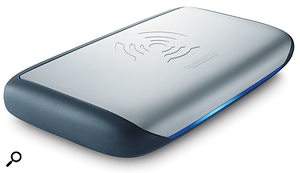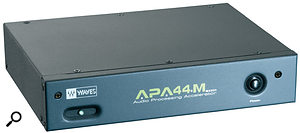I'm looking for advice on what's the best next step for improving my signal chain. I've got a budget of about £1000. I'm writing music to picture (so mainly instrumental, not too 'in your face'), mainly using sample libraries and the odd MIDI sound piped in from my Roland XV5080. I'll occasionally record live sources, but have so far never needed more than two inputs to do so.
My setup currently includes a Yamaha 03D mixer and a Focusrite Twin Trak Pro preamp, both with word clock, AES-EBU and S/PDIF I/O), and an M-Audio Delta 1010 audio interface with S/PDIF and word clock I/O. I never use more than two inputs on the 1010, but do use all eight outputs into the 03D for mixing down to a stereo pair. My sequencer is Apple Logic Pro 7 on a Mac G5, and I'm using Adam S3A monitors. I spent a large part of the summer knocking together traps and absorbers for my room, which now sounds pretty good.
So where would I get most bang for my buck? Should I get a word clock generator to help tighten things up? Something to replace the M-Audio interface? A friend suggested a summing mixer, but there seems to be so much discussion about whether these are voodoo or not that I wonder if I'd be capable of hearing the differences through my tin ears! I also appreciate that it might be worth going for better preamps, but I do so little live recording that I can't help but wonder if there's something else that would make more of an impact on my day-to-day studio work. Any thoughts?
SOS Forum Post
Reviews Editor Mike Senior replies: There are a few different possibilities here, I'd say. I can understand that you're a little reluctant to shell out masses of money on a new preamp, but have you thought of looking at a decent A-D converter instead? Something like the RME ADI2 would be a neat product for your purposes and price range, as it offers both A-D and D-A conversion, so it would not only improve the quality of all input signals, but also increase the resolution of the digital output from the Yamaha desk that feeds your main monitors.
Further up the scale are Apogee's Rosetta 200 and RME's ADI96 Pro, and although these are a little over the price range you stated, you should still give them some consideration, as they both have word clock outputs from their high-resolution internal crystals. Clocking your entire system from the converter's word clock output would then upgrade the sound of all the converters in your soundcard and mixer — in the case of the original 0-series mixers in particular, I've heard that this can make a big difference to the sound.

Another possibility to consider is a dedicated monitor controller and a second pair of monitors to go with it. This would allow you to stay objective about your mixes by flipping between the two sets of monitors during the mixdown process. The second pair of monitors doesn't need to be as good as your main pair, and could even function as the 'grot boxes' — monitors that will give you some idea of how your material will sound on lower-quality domestic systems.
The other advantage of a monitor controller is that it would allow you to quickly check the mix in mono (still important for broadcast work), and would also allow you to quickly and easily audition external sound sources on your main monitors — perhaps the output of a CD player or television, again for referencing purposes during mixing. Towards the lower end of your price range is the Mackie Big Knob, which is very flexible, but you might also want to have a look at the SPL Model 2381 or Presonus Central Station, the former for its more 'audiophile' bias, and the latter for its built-in digital source monitoring facilities and remote controller.
 A monitor controller such as the Mackie Big Knob, a quality A-D/D-A converter such as the RME ADI2 or an external plug-in processor such as the TC Electronic Powercore Compact or Waves APA44M would be welcome additions to just about any studio.
A monitor controller such as the Mackie Big Knob, a quality A-D/D-A converter such as the RME ADI2 or an external plug-in processor such as the TC Electronic Powercore Compact or Waves APA44M would be welcome additions to just about any studio.A final suggestion would be to look at some of the add-on DSP processors currently available, in order to increase the number and quality of plug-ins and virtual instruments that you can run using your single G5 Mac. There's lots of choice here within your price range, such as the Universal Audio UAD1 processor card bundles, several varieties of TC Electronic Powercore (both PCI and external Firewire), and the new Waves APA series. Which one you go for will depend on what plug-ins you're most likely to use, but you should see a significant increase in audio processing power in all cases. I imagine you already know how useful it is to have everything running live when the director changes the brief at the last moment!

Forum member Tomás Mulcahy also suggests exchanging the G5's audio interface for one with ADAT I/O, and then also buying the ADAT-equipped mini-YGDAI expansion board for the 03D. This would remove unnecessary extra stages of A-D and D-A conversion when transferring audio from the computer to the mixer, and would certainly improve the sound quality of the whole system. RME's Multiface and Digiface are both possibilities well within your price range, and as RME also have an excellent reputation for digital clocking you should still see some improvement in the Focusrite channels' A-D conversion and the Yamaha mixer's D-A conversion. Whether you want the analogue I/O provided on the Multiface will depend on your future expansion plans, but by the sound of things there's not that much need for it in your system, so the Digiface might be the better bet, as well as the cheaper one!

